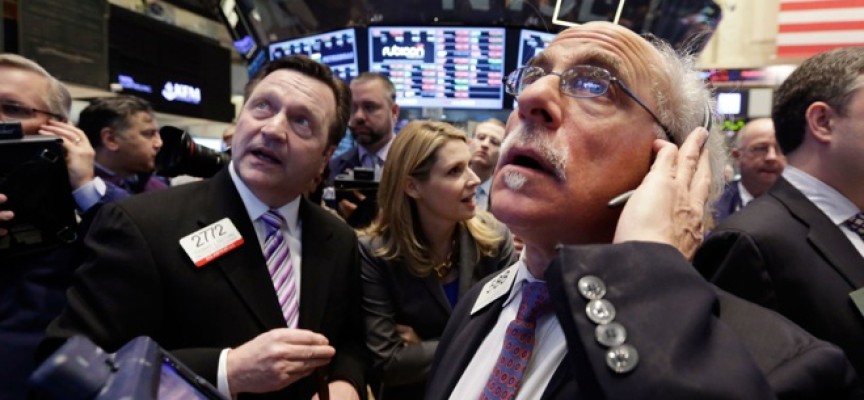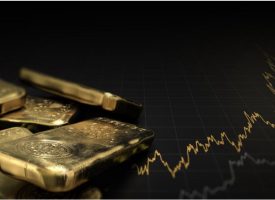Today a legend who was recently asked by the Chinese government to give a speech to government officials in China sent King World News a powerful piece that warns as major cracks appear in the global financial system, it's everyone, every currency and every central bank for itself.
By John Ing of Maison Placements
March 24 (King World News) – Much is made of America’s economy becoming one of the fastest growing economies in the world. It is all relative. Debt has grown even faster. The US dollar too has soared relative to other currencies, thanks in part to a relatively better economic recovery and of course the trillions from the Fed’s bond buying program. However, the US still has 47 million people on food stamps and unemployment remains stuck at 5.5 percent. The US is just the least ugly duckling while the rest of the world copes with its own serious challenges.
The US needs to grow and close the gap between the haves (who benefited from QE) and the have-nots (savers and pensioners hurt by zero interest rates). America’s growth is simply not sustainable because this debt load is heavily dependent upon the largesse of its creditors. In fact, the strong dollar makes America’s goods and services less competitive such that Obama and America’s lawmakers are threatening to enact a trade agenda attacking the “currency manipulators” aka trade wars.
Echoes of the Past
Still an influx of global liquidity has flowed into the US reminiscent of the late nineties, when money attracted by high returns flooded into Asia with supposedly limited exchange rate risk. Soon foreign investors headed for the exits when defaults rippled from Russia to Thailand and, of course their currencies collapsed. Also, “too big-to-fail” Long Term Capital Management closed their doors. The contagion spread later in 2008 when Iceland sparked another round of defaults as its indebtedness grew to ten times the size of Iceland’s economy. The first Eurozone crisis followed, unraveling with the initial default of Greek government bonds.
Months later, Cyprus’ economy collapsed in 2013 with bank depositors paying for the defaults. It never ends. The can is always kicked down the road. This long cycle of dysfunction in Europe and Washington still grows. Today, Greece is home to a debt crisis that is still in danger of boiling over. Venezuela is set to default and war-torn Ukraine will need more cash this year. Russia too is not insulated with giant Gazprom and Rosneff needing state support. Déjà vu. And, despite heavy indebtedness, the United States remains the most vulnerable with markets remaining complacent.
Currency Wars
The European Central Bank (ECB) has belatedly followed the United States, the UK and Japan in introducing a quantitative easing (QE) program. The ECB plans to spend more than a trillion euros leveraged by zero-cost borrowings to purchase sovereign debt in hopes to reverse deflation and an anemic economy. Europe’s sovereign bonds (Greek debt excluded) will be bought by the ECB with newly minted euros, which is a massive bet that growth will return.
However, even the French will have a deficit of over 4 percent, not registering a budget surplus since 1970. Four months from now, the threat of a Grexit will be back. Twice bailed out, Greece was looking for another handout from the EU-IMF troika but the recent history is not good and hopes are simply that they can kick the problem down the road.
We believe that Europe’s move to QE has laid bare a “stealth” currency war that has seen the euro fall from $1.40 a year ago toward parity with the dollar. Central banks reduced interest rates causing their currencies to fall against the dollar, reviving worries of a “beggar thy neighbor” currency war which was part of the Great Depression. Ironically, what was good for the goose is not good for the gander as the Americans complained about the ECB’s move to QE.
Return to Deflation
The whiff of deflation is everywhere. The arrival of deflation where a dollar today buys more than a year ago has caused panic amid falling benchmarks such as energy and interest rates. Virtually every central bank resorted to ever more unorthodox means to repair their economies are now in a fight to stave off deflation, creating speculative mountains of cash, causing nervousness over steadily falling prices.
German stocks have benefited from the ECB’s largesse. Cash is no longer king, or at least it doesn’t earn anything anymore. Sweden has followed the downward march of yields with the krona falling to a six-year low against the dollar. Nineteen central banks have set a labyrinth of negative interest rates. Somehow investors are willing to take less to park their money in sovereign debt, paying for the privilege of parking their money.
In fact, much of the talk of deflation was due to the halving of oil prices. Oil prices have actually fallen six times in the past three years. In the late seventies, we recall when a $10 a barrel oil price almost morphed into near hyperinflation levels. Today, while savers and retirees have been punished, medical services, smartphones, stock prices and classic car prices have experienced the opposite – price inflation. Walmart recently increased wages in a prelude to a wave of increases. Taxes too and of course debt have not fallen but increased. Inflation is back, we just don’t recognize its pervasiveness.
The central point is that the fall in prices is a reflection of the imbalances in the system. In the Thirties, the “beggar thy neighbor” deflation was caused largely by the contraction of money supply and credit. Deflation then was a negative year-to-year change in CPI. Today, nowhere have we seen this. Monetary policy continues to be expansive around the world, and while there have been threats of cutbacks, the monetary base elsewhere and at home has not been constrained. Real interest rates are negative, limiting the choices for central banks. And that is the point. We are experiencing disinflation as part of an inflationary cycle that ebbs and flows. Disinflation in fact is a prelude to inflation when the imbalances become extreme.
Part of the problem is that while the market is focussed on deflation, it provides an excuse for even looser policies, which will exacerbate the inflationary consequences to come. The other problem is that negative interest rates remove the most obvious shock absorber for policymakers leaving them without a policy cushion for increasing liquidity. The monetary playbook is empty, thus the move to currency wars. The boo-birds, bond investors and Mr. Krugman are just crying for even lower interest rates and bigger profits.
Balance Sheets on Steroids
Central banks printed money in massive amounts to buy “assets” of everything from low-yielding treasuries to mortgages to equities boosting their balance sheets on steroids. Balance sheets matter. That at least is one of the biggest lessons of the last financial crisis. We also know that the Swiss do not play games with money. Switzerland shed its peg to the euro because the Swiss National Bank’s balance sheet choking with euros, equivalent to 86 percent of Switzerland’s GDP, reached its limit.
The Fed’s balance sheet too has grown to the largest ever at a staggering $5 trillion, equivalent to 25 percent of America’s GDP. Noteworthy is that the equity capital of the central banks is only one twentieth their exposure such that central banks have become the world’s largest hedge funds with worse leverage than the hedge funds which collapsed in 2008. Of course, central banks can’t fail – they can always print enough to cover their liabilities. Or can they? Central banks simply have become part of the problem. The world is now awash with more debt than the last crippling financial crisis. When rates rise, the existential faith in central bank largesse will be tested. We think investors should be prepared for a meaningful rise in market volatility. Gold will be a good thing to have.
Of course, we are told that this printed money can always be sterilized before it reaches the economy. To date, this massive money printing exercise has benefited the big banks, which after a near-death experience in 2008 are holding trillions of reserves stuffed with ultra-safe debt driving down yields even further. Some banks are stockpiling cash, suggesting the economy is not as robust despite the political rhetoric. Others have huge reserves stashed with central banks. Small wonder that this cheap money has not filtered down into the world’s largest economy plagued by anemic growth and increased volatility.
Indeed, central banks having bought up sizeable amounts of their own government debt are now stymied, doing little for the all-important private sector. Then there is the complacent view that because America pays its bills with its own currency, its large and growing debt does not faze the markets, which prefer to celebrate daily highs rather than be concerned about the dollar’s lack of value. There seems to be no limit to the aggregate debt that global markets can absorb but this growth is illusory. Money printing is not yet inflationary only because money remains on the balance sheets of the rich banking sector. This is to change. When interest rates and long-term yields reverse – as they surely will, money will demand even higher and safer returns. And the dollar on borrowed time will fall as investors reverse the world’s biggest “carry trade.”
It’s Everyone, Every Currency, Every Central Bank For Itself
The problem is that the sums are so huge that hyperinflation is now a very real possibility. We believe that the imploding Middle East, a cold war with Russia and cracks within the Eurozone are sideshows to the largest money-making exercise in history. All this looks like a formula for a repeat of the Dirty Thirties with "beggar thy neighbor" competitive devaluations, social strife and falling interest rates. While central bankers are keeping their feet on the money accelerator, backed by those politicians who are addicted to low interest rates, the dilemma is that no one wants to take the punchbowl away. While America has stopped its asset purchases, dovish Fed Chairman Yellen’s rhetoric has been one of delay and bluff in a reluctance to take the necessary steps. It’s everyone, every central bank and every currency for itself.
The bond vigilantes are playing chicken with the Fed on interest rates, but the eventual unwinding will cause the Fed and other central banks to liquidate those leveraged balance sheets that are in fact larger than the market itself. And those sales will drain rather than add liquidity resulting in an increase in the much-feared volatility and of course, a move to liquid and "hard" assets. This change is ultimately inflationary and as volatility picks up, interest rates too will edge even higher. Indeed, when the Fed finally raises rates from near zero to a likely 0.25 percent, markets might go apoplectic. However, to put the maneuver into perspective, between 1954 and 2007 the average yield was 2.5 percent, not 0.25 percent.
Having exhausted a toolbox of easy money and deficit spending, as mentioned earlier, central banks have now resorted to currency wars. However, faced with excessive debt and the declining credit quality of consumers and governments, these de-facto devaluations put increasing pressure on the American big multi-nationals such that a coalition is building to push America to join this race to the bottom. The choices are narrowing: deflation, default, devaluation or more inflation. This unwinding will be dangerous. Gold, anyone?
Gold Is the Ultimate Store Of Value
We believe the inflection point will be reached when overseas creditors realize that they are to be repaid in depreciated US dollars, which are being produced on a massive scale. Gold historically has been a reliable store of value that is superior to fiat currencies. Were gold a currency last year, it would have been the second best performer of all currencies, after the US dollar. Our view is that gold has even deeper appeal. It is a hedge against the escalating currency war. In fact, gold’s recent rally in January is an early warning of a potential crisis over the loss of confidence in fiat currencies, especially the cheapened US dollar.
Importantly, gold miners have some 20,000 tonnes of unallocated gold in the ground while central banks’ hold some 30,000 tonnes of gold, which has been loaned many times after backing the billions of complex derivatives. Today there is an actual physical supply deficit in the gold markets. The century-old gold fixing was recently abandoned, coinciding with reports that the US Department of Justice (DOJ) and the Commodity Futures Trading Commission (CFTC) are investigating the ten major bullion banks for price rigging the "fixing." The investigation will tighten an already tight market. The valuation of the “in-situ” gold miners' reserves are at the lowest ever. Gold miners are a good thing to have.
Sure, gold lacks yield but so does the dollar today. Since 1971, when gold’s link to the dollar was severed, gold has outpaced consumer prices, stock markets and debt. Simply it is an alternative currency. Gold is money. Central banks can always create new money with the click of a mouse but the total supply of gold is finite. Thus, while our central bankers are busy creating money, other central banks led by Russia and the Chinese are buying gold. Nineteen banks bought gold last year, at the highest price in 50 years. And now, the continuation of quantitative easing in Europe only reinforces that paper money continues to be debased. Gold $2,000?
Meantime China, the world’s second largest economy, has built up an enormous mountain of foreign exchange reserves at $5 trillion of which a good part comprises US government securities. Although China has diversified by buying European assets and granting huge loans to emerging countries, China alone has purchased as much gold as all the central banks purchased last year or equivalent to half of gold produced last year.
We believe Chinese demand will buoy future gold prices. China is the world’s largest producer and consumer of gold. At the same time, the yuan has been one of the top-performing currencies. However, China too has weakened the yuan by 3 percent against the dollar, joining the stealth currency war, leaving only the United States alone. ***ALSO JUST RELEASED: Richard Russell: A World On The Edge Of Chaos – "God Help Us" CLICK HERE.
© 2015 by King World News®. All Rights Reserved. This material may not be published, broadcast, rewritten, or redistributed. However, linking directly to the blog page is permitted and encouraged.
The audio interviews with Bill Fleckenstein, Dr. Philippa Malmgren, Egon von Greyerz, Eric Sprott, Robert Arnott, Gerald Celente, Michael Pento, David Stockman, Marc Faber, Felix Zulauf, Andrew Maguire, John Mauldin, Dr. Paul Craig Roberts, Lord Christopher Monckton, John Embry and Rick Santelli are available now. Other recent KWN interviews include Jim Grant — to listen CLICK HERE.













